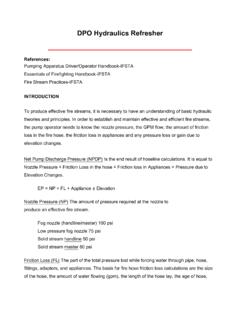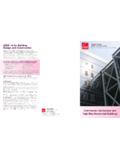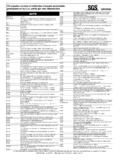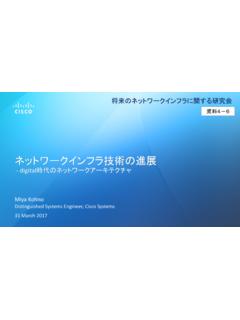Transcription of Information Logistics and Fog Computing: The DITAS …
1 Information Logistics and Fog computing : The DITAS Approach Pierluigi Plebani1 , David Garcia-Perez2 , Maya Anderson4 , David Bermbach3 , Cinzia Cappiello1 , Ronen I. Kat4 , Frank Pallas3 , Barbara Pernici1 , Stefan Tai3 , and Monica Vitali1. 1. Politecnico di Milano Dipartimento di Elettronica, Informazione e Bioingegneria Piazza Leonardo da Vinci, 32 - 20133 Milan, Italy 2. Atos Spain SA. Pere IV, 08018 Barcelona, Spain 3. TU Berlin Information Systems Engineering Research Group Einsteinufer 17 - 10587 Berlin, Germany 4. IBM Research Haifa Haifa University Campus, Mount Carmel, Haifa, 3498825, Israel Abstract. Data-intensive applications are usually developed based on Cloud resources whose service delivery model helps towards building reli- able and scalable solutions.
2 However, especially in the context of Internet of Things-based applications, Cloud computing comes with some limi- tations as data, generated at the edge of the network, are processed at the core of the network producing security, privacy, and latency issues. On the other side, Fog computing is emerging as an extension of Cloud computing , where resources located at the edge of the network are used in combination with cloud services. The goal of this paper is to present the approach adopted in the recently started DITAS project: the design of a Cloud platform is proposed to op- timize the development of data-intensive applications providing informa- tion Logistics tools that are able to deliver Information and computation resources at the right time, right place, with the right quality.
3 Applica- tions that will be developed with DITAS tools live in a Fog computing environment, where data move from the cloud to the edge and vice versa to provide secure, reliable, and scalable solutions with excellent perfor- mance. Keywords: Fog computing , Edge computing , Data movement, Cloud computing . X. Franch, J. Ralyt , R. Matulevi ius, C. Salinesi, and R. Wieringa (Eds.): CAiSE 2017 Forum and Doctoral Consortium Papers, pp. 129-136, 2017. Copyright 2017 for this paper by its authors. Copying permitted for private and academic purposes. 1 Introduction Fog computing [9], often also referred to as Edge computing [12], is an emerg- ing paradigm aiming to extend Cloud computing capabilities to fully exploit the potential of the edge of the network where traditional devices as well as new generations of smart devices, wearables, and mobile devices the so-called Inter- net of Things (IoT) are considered.
4 Especially for data-intensive applications, since IoT is a source for enormous amounts of data that can be exploited to provide support in a multitude of different domains ( , predictive machinery maintenance, patient monitoring), this new paradigm has opened new frontiers. Nowadays, the typical approach for data processing relies on cloud-based applications: data are collected and pre-processed on the edge, then they are moved to the cloud, where a more scalable and reliable processing environment is provided. Finally, the output of the analysis is sent to the end user, whose devices are again on the edge. While the cloud offers virtually unlimited compu- tational resources making data processing extremely efficient, the resulting data movement could have an impact on the application performance due to possibly significant latencies of the transmission.
5 To improve this type of applications, proper Information Logistics become fundamental for delivering Information at the right time, the right place, and with the right quality [10]. However, develop- ing applications that are able to deal with these issues can be really challenging for several reasons: heterogeneity of devices at the edge, privacy and security issues when moving data from the edge to the cloud, or limited bandwidth. The goal of this paper is to introduce the recently started DITAS project which aims to improve, through a cloud platform, the development of data- intensive application by enabling Information Logistics in Fog environments where both resources belonging to the cloud and the edge are combined. The resulting data movement is enabled by Virtual Data Containers which provide an ab- straction layer hiding the underlying complexity of an infrastructure made of heterogeneous devices.
6 Applications developed using the DITAS toolkit will be able to exploit the advantages of both cloud-based solutions about reliability and scalability, and edge-based solutions with respect to latency and privacy. To properly discuss the relevant aspects of Information Logistics , Fog comput- ing as well as challenges that need to be faced, the rest of the paper is organized as follow: Section 2 proposes the DITAS vision on Cloud, Fog, and Edge com- puting. Details on the importance of Information Logistics in general, as well as in Fog environments in particular, are discussed in Section 3. Section 4 gives an overview of the DITAS approach with emphasis on the architectural description of the proposed cloud platform. 2 On the Fog, Edge, and Cloud computing Cloud computing [7] has been widely adopted as a model for developing and providing scalable and reliable applications in a cost-efficient way with minimal infrastructure management efforts for developers.
7 In such an environment, com- putational resources as well as storage capacity can be considered unlimited, 130. which has boosted the proliferation of applications able to manage huge amount of data. Nevertheless, relying only on Cloud computing or even on federated clouds [6] could have some drawbacks especially when the data to be processed are generated by devices located at the edge of the network. If we consider that predictions for IoT estimate about 32 billion connected devices in 2020. that will be producing about 440 Petabytes per year (accounting for 10% of the world data) [13], the impacts of data movement between edge-located resources where data are produced and the cloud-located resources where data are processed and stored can be significant.
8 In the telecommunication sector, when Cloud resources Edge resources Fog computing Fig. 1. Fog computing environment mobile devices moved from being simple consumers of contents to being produc- ers of contents, the term Fog computing has been coined to identify a platform able to provide compute, storage, and networking services between Cloud data centers and devices at the edge of the network [3]. The term Edge computing has been instead proposed by Information systems engineering researchers when IoT was recognized as a great opportunity for providing new services. It iden- tifies the technologies allowing the computation to be performed at the edge of the network, on downstream data on behalf of cloud services and upstream data on behalf of IoT services [11].
9 Based on these definitions, Cloud computing is mainly related to the core of the network whereas Edge computing is focused on providing to the owner of resources the local 'in-situ' means for collecting and preprocessing data before sending it to cloud resources (for further utilization), thus addressing typical constraints of sensor-to-cloud scenarios like limited bandwidth and strict latency requirements. For this reason, also in the light of the definition proposed by the OpenFog Consortium [9], we here after consider Fog computing as the sum of Cloud and Edge computing . As shown in Figure 1, cloud resources include physical and virtual machines which are capable of processing and storing data. On the other side, smart devices, wearables, or smartphones belong to the set of edge-located sources.
10 While Cloud computing is devoted to efficiently managing capabilities and data in the cloud, Edge computing is focused on providing the 131. means for collecting data from the environment (which will then be processed by cloud resources) to the owner of the available resources. On this basis, Cloud and Edge computing are usually seen as two distinct and independent environments that, based on the specific needs, are connected to each other to move data usually from the edge to the cloud. Exploiting the Fog computing paradigm, in DITAS these two environments seamlessly interoperate to provide a platform where both computation and data can be exchanged in both downstream and upstream direction. For instance, when data cannot be moved from the edge to the cloud, , due to privacy issues, then the computation is moved to the edge.




